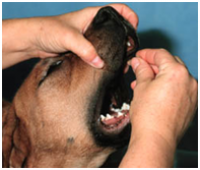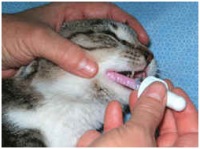Giving Medicine to Pets
Dogs and cats can both be a challenge at times when it comes to giving medicine. It seems like the more important the medicine is, the more they fight you! We have struggled with our own pets, so we can empathize.
Giving Pills and Capsules
The tried and true method for pills is to open your pet’s mouth, put the pill at the back of his tongue, close his mouth, and rub his neck to make him swallow, being careful so you don’t get bitten. In some cases, this really does work.
On the other hand, if your pet is like many cats out there, as soon as you try to open her mouth, she turns into a bobble-head and whips her head in every direction. There is no way you're going to get that pill into the cat.
To give a pill directly to these kind of pets, you can also get a device that “shoots” the pill into your pet’s mouth. The advantage of this is you are less likely to be accidentally bitten and it works with some pets.
Washington State University has some good photos of how to give pills to both dogs and cats. The cat one shows how to use a pilling device and both also show how to give liquids. If your pet is as cooperative as the ones in the pictures, it should be easy for you!
Giving Liquids
Giving liquids may be easier. (see information below about compounding). Put the dropper or syringe into the side of his mouth where there’s a pouch between his cheek and teeth. Squirt the liquid into the pouch. It sounds easy, but, again, if your pet is moving his head a lot, it can be difficult. Make sure you keep your pet’s mouth closed so he doesn’t spit it out.
It’s also easier to get a liquid medicine, more so than pills, into your pet’s windpipe. Do not tip your pet's head back when you are giving a liquid medication and never, ever squirt the liquid directly down your pet's throat. It can be serious if your pet inhales the medicine.
Using Food or Treats
There may be another way. If you are giving pills, start with the “meatball” method. Take a small amount of canned food, meat baby food, peanut butter, cream cheese, squeeze cheese, mini-marshmallows, small pieces of hot dog, or whatever your pet loves. Give a bite or two of the food without a pill. Then cover a pill well with the food and offer it to your pet.
Many dogs will gulp it down. Cats are more likely to chew their food so you can’t trick them as easily. They may eat the food and spit out the pill. You can also buy Pill Pockets® and other treats that are made to hide pills in. Most pets, even cats, like these treats.
Sometimes you can crush the pill or open a capsule and mix the powder with soft food. Others, you can even find in flavored liquids that will mix in with soft food. Find out from your vet if the medicine is bitter or has a bad taste. If so, it may be harder to hide in food when it’s crushed or dissolved.
Compounding Medications
If you are not having success, ask your veterinarian about a different method. Some medicines come in a flavored version that your vet may be able to give you. Your vet may have also have a different medicine that will work as well but tastes better or comes in a different form.
You can also talk to your vet about compounding the medicine into a form your pet will take. Compounding is done at certain pharmacies and needs a prescription. Your vet may even have a compounding pharmacy that works with your vet's hospital. The pharmacist may be able to make the medicine into a flavored liquid that your pet will eat or into a chewy flavored tablet. Some medicines can also be made into micro-pills that are easier to get down your pet's throat either manually or with a pill popper device, and might even be easier to hide in food. In some cases, a medication can be made into a gel that is applied to the inside of your pet’s ears for the medication to be absorbed into the body from the skin.
Summary
If your pet needs medication, it’s important that he take it completely. If he needs it long term, it’s critical you find an easy, sustainable method of delivering that medication. Too many people struggle to give medications and become frustrated and give up on administering it. Plus, the medicine won’t help if it stays in the bottle or your pet spits it onto the floor.
Keep an open dialogue with your veterinarian about struggles you're having in giving medicine to your pet until you find a solution that works for you!
All articles are reviewed and maintained by whiskerDocs team of veterinary experts.



